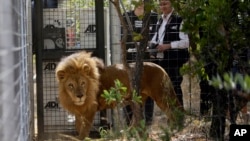The roars of lions filled the cargo section of Johannesburg's OR Tambo International Airport Saturday evening as 33 lions rescued from South American circuses landed in South Africa where they will be released into a bush sanctuary for big cats.
It was the largest airlift of lions in history, said Jan Creamer, president of Animal Defenders International, which carried out the operation.
"These lion have suffered tremendously,'' Creamer said as the lions were loaded in crates onto trucks.
"They lived in small cages on the backs of trucks for their entire lives. Some of them had their teeth bashed in with steel pipes in circuses in Colombia and Peru. Some of them had their claws removed. ... It is a wonderful feeling to bring them back to their home.''
Nine of the lions were surrendered by a circus in Colombia. The remaining 24 were rescued in raids on circuses in Peru by the animal defense group and officials enforcing a crackdown on wildlife trafficking.
The lions will be placed in quarantine in enclosures at the 5,000-hectare (12,355-acre) Emoya Big Cat Sanctuary in Vaalwater in northern South Africa, started three years ago by a single mother and her teenage daughter.
The 33 lions will be monitored by a vet for their first weeks in Africa. They will then be introduced to each other in a 1-hectare (2.47-acre) bonding enclosure. Many of the lions were never allowed to have direct physical contact with other lions and have never been together without a fence or a cage separating them.
Due to their poor physical state, the lions will never be able to hunt again and will have to be cared for with food and water for the rest of their lives. Emoya will feed the cats with game meat which it buys in bulk.
The enclosures will be fitted with drinking pools, platforms and toys to ensure the lions don't become bored and will be steadily expanded as they become familiar with their new life, said Savannah Heuser, who started Emoya with her mother.
Emoya, in an area with a mix of habitats including mountainous regions, rolling grasslands, forests, cliff caves and river gorges, has a strict non-breeding policy, Heuser told The Associated Press.
Female lions may receive contraceptive medications so they can remain with their mates, while males may undergo vasectomies to make sure that no lions are bred in captivity.
"The animals have no conservation value whatsoever. Many of them have been inbred,'' she said. "When we are sure that no breeding will take place, we allow males to interact with females. By then a pattern will have emerged ... and we will know which lions can be placed together.''
Emoya was opened in 2012, when Heuser was 16. The sanctuary's first cat, a lion rescued from Cairo called Chanel, arrived in June 2013. The sanctuary is currently home to eight big cats, including two Siberian tigers.
The lions are part of 100 animals that were rescued in Peru. Bears, monkeys, birds and other native wildlife have been relocated to sanctuaries in Peru and a tiger has been sent to a new home in Florida.
33 Rescued Lions Arrive in South Africa in Airlift

JOHANNESBURG —





